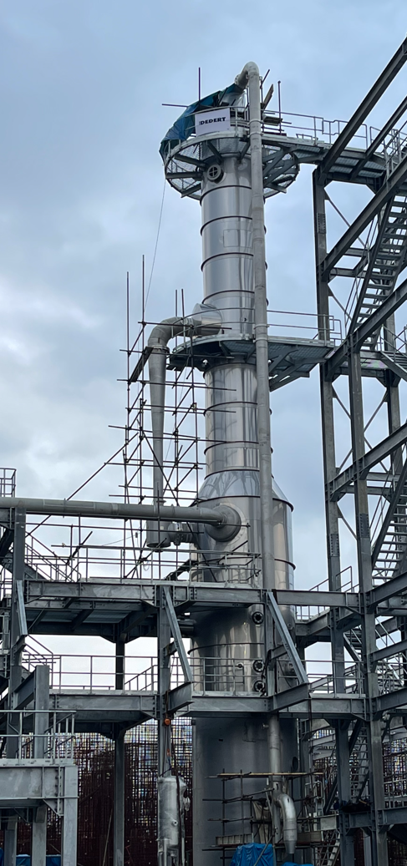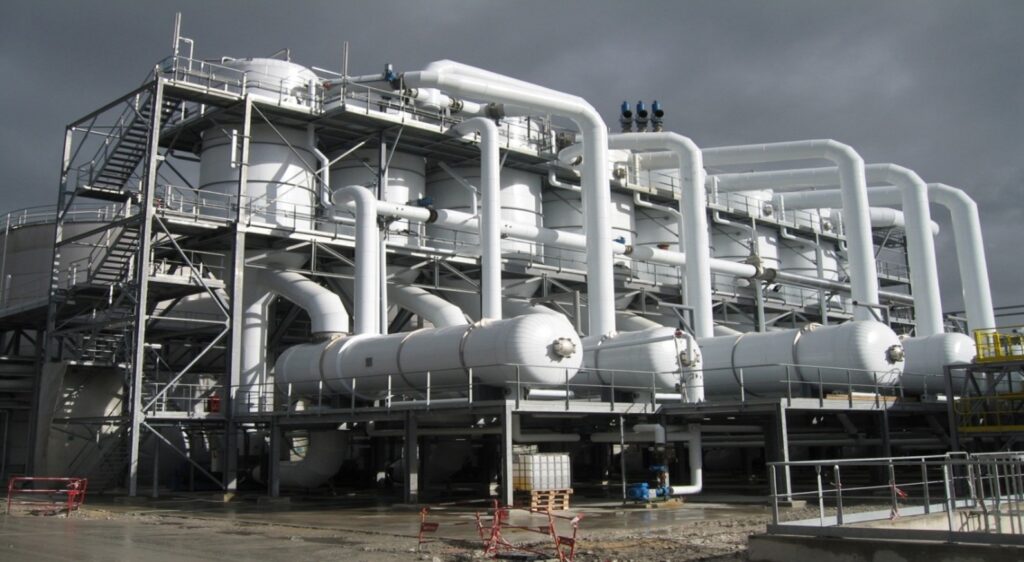Evaporators are devices that are used to remove liquid from a solution or a suspension, by heating the mixture to promote evaporation. They are an essential component of many industrial processes, including chemical, pharmaceutical, food, beverage production, and wastewater treatment industries.
There are different types of industrial evaporators available in the form of shell and tube, plate and frame and thin film. Typically shell and tube evaporator types include falling film, rising film evaporators, and forced circulation. Typically plate and frame evaporator types include rising film and forced circulation. Each type has its unique features and advantages depending on the specific application and process requirements.
In this article, we will discuss:
Engineers design evaporators based on the physical phenomenon of evaporation, concentrating a solution by converting the volatile liquid into the vapor phase by adding heat energy to the system. The heat source is normally either from condensing or cooling a liquid at a higher temperature and pressure than the solution which is being concentrated.
The basic components of an evaporator are:
The energy sources of evaporators are listed below:
Steam Heated Evaporators are preferred when low pressure steam is available and inexpensive. The steam is condensed on the shell side of the evaporator, which operates at a higher pressure than on the tube side and drives evaporation. The evaporation from the first effect is used as the heating source for the subsequent effect. The vapors produced in the last effect are condensed in a condenser. Steam cost, overall available temperature differential, space requirements and product characteristics are considered to optimize the number of effects.
Dedert originally introduced Mechanical Vapor Recompression (MVR) to the corn wet milling industry over 40 years ago. The evaporator components are like steam driven systems, but with the addition of a mechanical compressor or fan. Mechanical energy compresses evaporated process vapor to a higher pressure and condensing temperature, and returns it to the process, minimizing steam consumption.
With increased gas prices, MVR has become the popular option for reducing operating costs, especially at higher evaporation rates. Fewer vessels are required than in steam powered multiple effect systems, resulting in lower installation costs.
Thermal Vapor Recompression (TVR) system is more energy efficient than a steam heated system when medium to high pressure steam is available. The motive steam enters through the nozzles and draws in recycled suction vapor. The vapor mixes in the converging section, and the recycled vapor is boosted to an intermediate pressure. Recycling the suction vapor allows for a lower steam consumption. Thermocompressors are more efficient when they are recycling more vapour, producing a lower boost and therefore requiring less steam.


As part of the movement for sustainable future, increased efforts have been made in finding ways to reuse energy from other parts of the plants. Dedert has long been a pioneer in waste heat recovery and was granted the US patent for an evaporator chest with built-in scrubber for the corn wet milling industry.
Integrating evaporators to take advantage of the free energy from dryers or distillation columns reduces the plant overall energy consumption and impact on the environment. There is also a reduction in energy requirements for the downstream emissions handling equipment.
An evaporator can use many different energy sources in lieu of steam and Dedert has considerable expertise in making use of otherwise wasted energy sources:
Integration can also reduce capital expenditures:
If we separate the working process of an evaporator into stages, they will typically look as the following:
The type of evaporation as well as the design and operation of an evaporator depend on various factors, such as:
Each type of evaporator, e.g., falling film or forced circulation has its unique design and operating principles. We will discuss the types of evaporators a bit later. Let’s look at their design considerations first.
When Dedert designs an evaporator for an industrial application, we must consider a few key factors, including:
Delta T is the temperature difference between the heating source and the liquid to be evaporated. This is the driving force for evaporation.
The evaporator must provide sufficient heat transfer area to enable efficient heat transfer for a given delta T between the heating medium and the liquid to be evaporated.
The evaporation is the capacity of the evaporator. This is he amount of vapor produced at a given process liquid feed rate and concentration profile.
To maintain the desired concentration in the evaporator, the process feed rate is controlled in order to provide a stable steady state operation.
Sustainability is a key factor in today’s industrial designs. The Dedert evaporator design focuses on achieving the best possible energy efficiency and Total Cost of Ownership for the client by optimizing the heat transfer area verses the various available energy sources.
The separation efficiency is the degree of separation between the vapor and the liquid. The type of separation medium and the design of the separator is determined by the separation efficiency required and the physical properties of the process liquid, such as density and viscosity.
Our selection of the material of construction for the evaporator is based on the chemical and physical properties of the process liquid being evaporated. Resistance to corrosion and erosion resulting from the liquid, heat, and other environmental factors are important.
To ensure optimal performance and longevity of the equipment, the functionality of the Dedert evaporator design strongly considers ease of maintenance and cleaning.
There are several types of evaporators used in industrial settings, each with its own advantages and disadvantages. The choice of evaporator depends on the specific application and the properties of the liquid mixture being concentrated.
Some of the most common types of evaporators are:
It is by far the most widely used type of evaporator.


In falling film evaporators, the liquid to be evaporated is fed onto a vertical tube or plate. The liquid forms a thin film on the surface of the tube or plate, and the heat is applied to the outer surface. The vapor generated from the liquid flows downward or upward and is condensed in a separate vessel or condenser.
The following are some advantages of falling film evaporators:
Typical industries that use Falling film evaporators are the food, pharmaceutical, and chemical industries.
When there is a risk of fouling or at high temperatures or scaling with salts that are likely to precipitate, the forced circulation type of evaporator maintains a full tube, which mitigates this risk.


In Forced Circulation Evaporators, the liquid is pumped through a heat exchanger, where it is heated. The liquid then continues to a flash vessel, where it is depressurized, causing the volatile liquid to vaporize.
The following are some advantages of forced circulation evaporators:
Typical industries that use forced circulation evaporators are the distillery, pulp and paper, chemical, and pharmaceutical industries.
Another type of evaporator that we use for low to medium-viscosity liquids is the Rising film type.
In Rising Film Evaporators, the liquid is fed into a vertical tube, and heat is applied to the outer surface of the tube. The liquid forms a thin film on the surface of the tube, and the vapor generated flows upward and is condensed in a separate vessel or condenser.
The following are some advantages of falling film evaporators:
The food and dairy industries are the most common users of Rising film evaporators.
Tubular and Plate evaporators both have their own advantages and disadvantages. The choice of a hybrid system depends on the specific application and the properties of the process liquid.


A forced circulation plate develops higher shear rates which reduce viscosity and power consumption. It is economical for smaller applications. Tubular forced circulation is economical for larger capacities, take up less floor space and are easier to maintain and clean.
A rising film plate is a perfect solution for small capacities and clean process liquors. Like the forced circulation, the falling film or rising film tubular evaporators, are economical for larger capacities, take up less floor space and are easier to maintain and clean.
If you haven’t guessed already, evaporators are essential equipment for many industries, including food and beverage, chemical, pharmaceutical, and environmental. They are highly useful in industrial settings as they offer several benefits, including:
Improving the efficiency of production processes by concentrating liquids, reducing the volume of materials to be handled, and decreasing the energy required for drying, transportation and storage.
Improving product quality by removing impurities, reducing microbial growth, and preserving the flavor and nutritional value of the product.
Significant cost savings by reducing the volume of liquid to be transported and stored, and reducing energy consumption and operational costs, especially if the product needs to be dried.
Reducing water consumption, decreasing wastewater discharge, and reducing environmental impact.
Dedert's Evaporation Technology is a game-changer in the industry due to its energy efficiency, robust construction, low maintenance, and flexibility to meet specific client requirements. The company has been offering process optimization solutions for over 55 years to reduce waste, increase efficiency, reclaim by-products, and save energy, all while reducing operating costs.
One of Dedert's specialties is process optimization. We offer different types of heat transfer surfaces and energy sources to provide customers with energy-efficient, robust, low-maintenance, and flexible evaporator systems. When configuring each system, we consider various factors such as:
Dedert has also been at the forefront of waste heat recovery for quite some time, and as a result, we were awarded a US patent for our innovative evaporator chest with a built-in scrubber that caters to the needs of the corn wet milling industry. Our expertise in waste heat recovery and our ability to integrate evaporators with other plant equipment reduces overall energy consumption and impact on the environment.
This is why Dedert is now a household name to many industries and has made it a go-to solution provider in the market.
Evaporators have become increasingly valuable equipment in industrial settings due to their many benefits. While they have long been a necessary component for many industries, the growing demand for sustainability has made them even more essential. Choosing the right type and design of the evaporator depends on the specific application and properties of the liquid being concentrated. With the help of a reliable solution provider like Dedert, proper design, and implementation of standard operating procedures, the chosen system can lead to improved efficiency, reduced operating costs, and consistent product quality.
In the food processing industry, evaporators are typically made entirely of stainless steel. This material is preferred because it is resistant to corrosion, easy to clean, and does not react with food products. The use of stainless steel in evaporators ensures that food products are not contaminated, and that the equipment can withstand the harsh conditions of food processing environments. Additionally, stainless steel evaporators provide excellent heat transfer properties, allowing for energy efficient concentration of food products.
Yes, an evaporator is a heat exchanger used in heat exchange processes to transfer the heat of one fluid into the latent heat of vaporization of another fluid. Typically, if an evaporator is employed to convert water or an aqueous solution from liquid to vapor state, it is called an evaporator. The evaporator's design, type, and size depend on the properties of the fluids involved in the heat exchange process, as well as the intended application.
©2024 Dedert Corporation. All Rights Reserved.